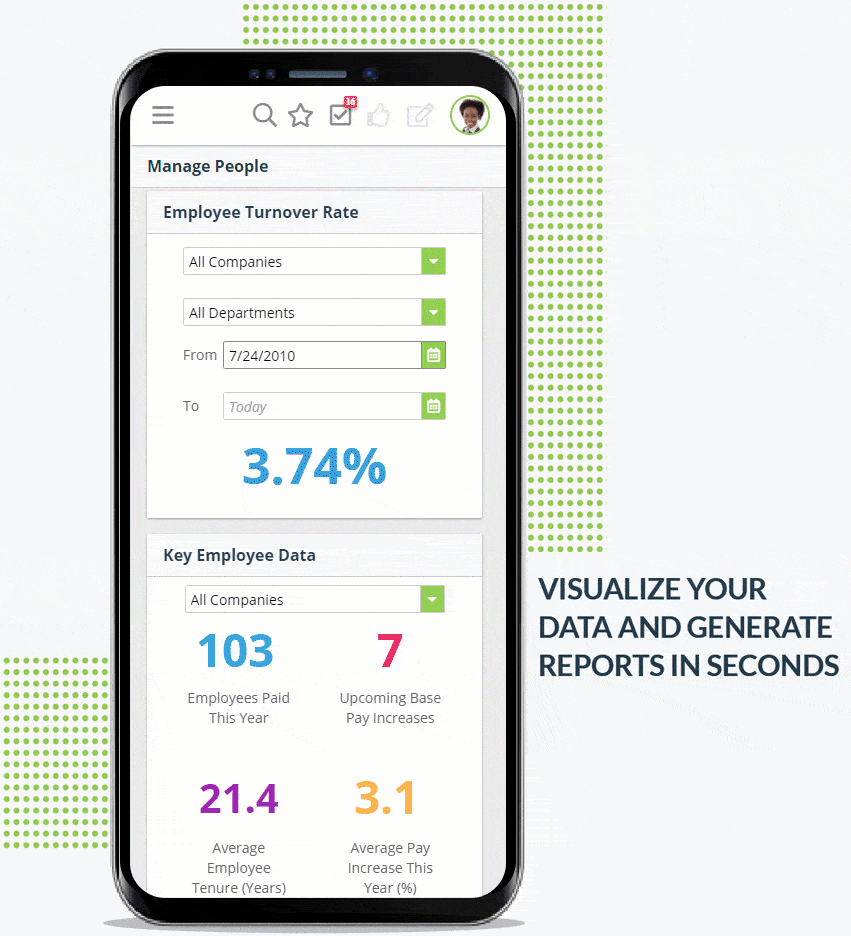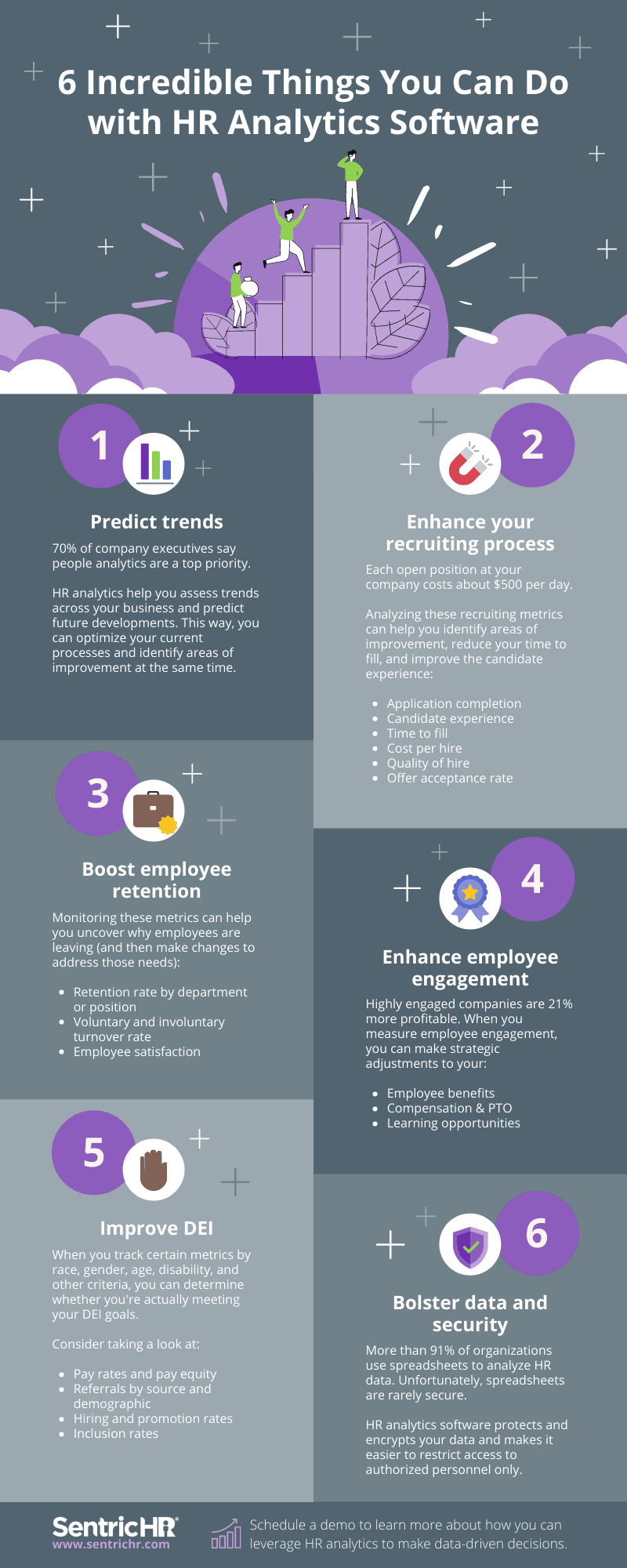Key points about the importance of HR analytics:
- HR analytics is the process of collecting and analyzing your HR data to make strategic informed decisions for your business.
- Predictive analytics can improve your workforce planning, including talent acquisition, retention, DEI, data security, and more.
- Analyzing your data may sound daunting, but software makes the process easier.
- What is the purpose of HR analytics?
- What’s the difference between HR analytics and reporting?
- Which HR metrics should you track?
- What is HR analytics software?
- What are the benefits of HR analytics?
- Do you need predictive analytics software for HR?
- Stand-alone vs. all-in-one HR analytics software
- Other features to look for in a workforce analytics solution
- HR data & analytics can help you adapt
- Incredible things you can do with HR analytics infographic
Each day, your HR department collects important information about your company and employees. HR analytics is the process of analyzing this information to make data-driven decisions. An HR analytics strategy can improve your bottom line and mean the difference between a good business and a great one.
What is the purpose of HR analytics?
HR analytics refers to the process of collecting and analyzing HR data to measure your organization’s performance and effectiveness. Analyzing this data gives you insight that you wouldn’t be able to get otherwise. You can then use those insights to make data-driven decisions and improve your business in almost any area.
HR analytics is also known as people analytics, talent analytics, or workforce analytics.
What’s the difference between HR analytics and reporting?
In theory, the difference between HR analytics and HR reporting is simple. Reports show you what is happening. Analytics go a step farther and show you why something is happening.
In reality, though, reporting and analytics are often confused. In fact, many company leaders say that their HR “analytics” are actually just reports.
This confusion usually results from the different types of analytics that companies track. Analytics can be broken into 4 general categories:
- Descriptive analytics tell you what happened in the past.
- Insightful analytics help you gain insights and identify trends.
- Predictive analytics use machine learning and statistics to help you make predictions about the future.
- Prescriptive analytics help you make decisions that will improve your business.
Of these four, descriptive analytics are the most widely used by 68% of organizations. Chances are your business already uses them. However, descriptive analytics are also the most similar to standard reports. Their usefulness is limited.
To gain real, lasting value from your data, focus on analytics that are actionable and future-focused. Predictive and prescriptive analytics are closer to true human resources analytics. They’re more valuable since they look towards the future and can help you make strategic business decisions. Unfortunately, only 43% of organizations use prescriptive analytics. That number falls to 34% for predictive analytics.
Which HR metrics should you track?
The HR metrics you track will vary depending on your business needs and strategic goals. Many companies get started by tracking these key metrics:
- Absenteeism
- Diversity and inclusion
- Employee engagement
- Time to fill
- Turnover rate
What is HR analytics software?
HR analytics software is a tool that helps you collect and analyze key workforce data. Software simplifies the process, making it easier to visualize valuable employee data and draw insights that can drive HR decisions. These decisions have the power to impact your organization’s growth plan, budget, and more.
What are the benefits of HR analytics?
70% of company executives say people analytics are a top priority. But few companies give them the attention they deserve, even though they have proven benefits. HR analytics and analytic software can help you:
Predict trends across your business
Part of the appeal of HR data analytics is that they help you assess trends and predict future developments. While you can analyze your workforce data yourself, software makes the job easier. With automation and machine learning, you don’t need to be an expert analyst to get the information you need.
In some cases, an HR analytics tool can even spot patterns that you might otherwise miss. This can help you further optimize your current processes and identify areas of improvement.
Enhance your recruiting and talent acquisition processes
63% of job seekers will reject a job offer because of a bad candidate experience. In today’s competitive job market, this is a risk you may not be able to afford. After all, each open position at your company costs you about $500 per day.
Analyzing your data can help you improve your talent acquisition process and fill positions faster. You can track key recruiting metrics like:
- Application completion
- Candidate experience
- Time to fill
- Cost per hire
- Quality of hire
- Offer acceptance rate
These business analytics can help you improve the candidate experience and find quality hires. For example, are multiple candidates dropping off at the same point in the application process? If so, this section may be taking too long to complete. Or it may not be optimized for mobile devices. With these insights in mind, you can make the proper adjustments.
Boost employee retention
Retaining your current employees is just as important as acquiring new ones. After all, it costs about six to nine months of an employee’s salary to find and train their replacement.
People analytics can help you uncover why employees are leaving or staying. You can then use this information to increase employee satisfaction and boost retention. HR analytics software helps you track:
- Overall retention rate
- Retention rate by department, position, or another element
- Voluntary and involuntary turnover rate
- Cost of turnover
- Employee satisfaction
Enhance employee engagement
Because employee engagement impacts other important business factors, it’s an important metric to track. For example, companies with highly engaged employees are 21% more profitable. They also see 41% less absenteeism.
Analyzing employee engagement gives you insight into the overall employee experience. Based on your findings, you can make necessary strategic improvements like revamping your:
- Employee benefits
- Compensation
- Paid time off
- Learning opportunities
- Scheduling options
Improve your DEI efforts
Diversity, Equity, and Inclusion (DEI) is a priority for many businesses right now. While setting DEI goals is one thing, tracking their success is another. HR analytics software can help you see whether your efforts are actually working. You can measure things like:
Pay equity
On average, women only earn 84% of what men earn. If you want to compare pay rates between men and women at your organization, software lets you easily account for various factors like:
- Tenure
- Geographic location
- Work experience
Hiring bias
Implicit bias and unconscious racism, ageism, and sexism can influence who you recruit and hire. Software helps you visualize biases and trends you may not be aware of.
As an example, referrals are one popular way to recruit new talent. But referrals still largely favor white men. In a way, this makes sense. If your workforce isn’t already diverse, referrals will only bring in individuals similar to your current demographics.
Some software solutions let you track your referrals by source and demographics so you can better understand the process at your company. If your referrals aren’t as diverse as you’d like them to be, that doesn’t mean that you shouldn’t use referrals as a means of finding new talent. Research suggests that if you want diverse referrals, all you have to do is ask!
Promotion rates
For every 100 men promoted to a manager position, only 85 women advance. The promotion rates for women of color are even lower. With software, you can track promotions by gender, race, and other criteria.
This can bring your attention to major discrepancies. For instance, you may be promoting white men at a much higher rate than everyone else. To remedy this, you might create a policy that outlines promotion criteria. These guidelines will help you and your managers evaluate everyone fairly.
With software, you can also track promotion rates over time. So once you’ve made some changes to your policies or practices, you can see whether they were actually effective year over year.
Inclusion rates
Inclusion can be difficult to measure since it refers to a sense of belonging in the workplace. But it’s still important to assess how comfortable different communities, like non-binary employees, feel in your work environment.
HR analytics software can help you get a pulse on inclusion in your company. By looking at things like participation, collaboration, and communication, software can help you determine whether certain employees are included in conversations and asked to drive business decisions. These metrics may not provide a definitive answer, but they can point you in the right direction.
Bolster data security and safety
According to one study, 91% of surveyed organizations use spreadsheets to perform HR data analysis. Another study found that 68% of HR professionals share analytics with company leaders via email. At face value, there’s nothing wrong with either practice. However, they both involve a certain amount of risk from a data security standpoint.
If these spreadsheets or emails aren’t protected, the data in them is vulnerable. With analytics software, you can analyze and store sensitive HR information in one secure platform. This way, you won’t need to transfer data from one place to another and increase the chance of security risks. If your HR manager needs to share the insights with anyone, the information is encrypted and can only be accessed by the teams and individuals you authorize.
Do you need predictive analytics software for HR?
You may not think you need HR analytics software the way you might need something like payroll software. But it can make just as much of a difference in your workplace.
According to one survey, 55% of talent professionals need help putting basic people analytics into practice. HR analytics software fills this role by giving you the tools you need to analyze your data and turn those insights into action. At its core, this software helps your HR department play a more strategic business role.
HR analytics software may be right for your business if you want to:
- Make smart decisions based on data
- Implement new HR strategies or solutions
- Monitor the effectiveness of a process or policy
- Reduce turnover
- Increase revenue
Stand-alone vs. all-in-one HR analytics software
If you’re interested in HR analytics software, you’ll need to decide whether a stand-alone or all-in-one solution is right for your business.
Stand-alone predictive analytics software for HR
Stand-alone HR analytics software is a platform designed specifically to help you collect, track, and analyze HR metrics. These solutions have robust analytic capabilities that really let you dive into your data. This type of software usually works best for businesses that:
- Need to track niche or highly specific metrics
- Already have software for payroll and other HR needs
While stand-alone software can simplify HR analytics, it does still require some work. If you store your retention, recruiting, performance, and other employee information in a different system or a spreadsheet, you’ll need to pull that data into the software or make sure it integrates with your chosen HR analytics platform.
When you have to export information from one system to another, the process takes time. If your data doesn’t automatically update in real-time between systems, you also run the risk of analyzing, and making decisions based on, outdated data.
All-in-one HR analytics software
More than one third of survey respondents said that they pull data from four or more systems to create people analytics reports. 4% even pull data from twelve or more systems!
An HRIS provides a complete solution for all of your HR needs. This means that you can manage your HR processes like recruiting, hiring, payroll, time tracking, and more alongside the related HR data. You can pull reports and visualize trends in the same software you use to manage your day-to-day processes. You won’t need to move data between systems in order to analyze it.
This type of software is often best suited for businesses that:
- Need HR analytics plus payroll, time tracking, and other HR processes
- Want to use a single system for all of their HR data
Other features to look for in a workforce analytics solution
Regardless of whether you choose a stand-alone or an all-in-one solution, look for a platform with:
- User-friendly features – Make sure your chosen solution is easy to use and understand. This is especially important if your team isn’t well-versed in data science and analysis. Software should make their jobs easier, not introduce new complexities and confusion.
- Cloud-based software– Cloud-based solutions allow you to analyze your data in real-time. They also back up your critical information to reduce data loss. These platforms tend to be less expensive since you don’t need to invest in hardware and other equipment.
- Predictive analytics – Predictive analytics are invaluable to a true analytic solution. Look for software with machine learning that can help you assess your past data to predict future outcomes. This will take some of the guesswork out of your decision-making.
- Visual tools – While compiling your data is important, numbers alone can be difficult to understand at a glance. A quality HR analytics solution will help you visualize your data with charts, graphs, and other elements.
HR data & analytics can help you adapt
91% of organizations use basic tools like spreadsheets to analyze their data. But only 48% of organizations use analytics that are embedded in their HR or talent systems. The HR industry is changing rapidly. HR analytics software, especially within a complete solution, can help you keep up with these changes and give you an edge over the competition.
SentricHR’s all-in-one HRIS gives you the power to manage all of your HR processes plus store, analyze, and act on your data. Since all of your HR information is stored in one place, you don’t need to move data between systems or spend money on multiple platforms.
To learn more about how our software can help you make data-driven decisions, speak with one of our product experts today!










